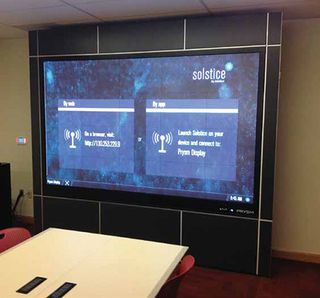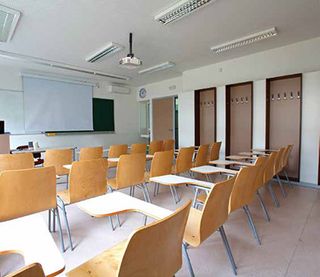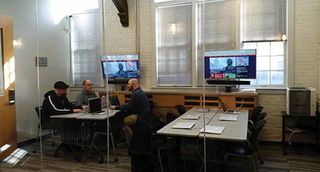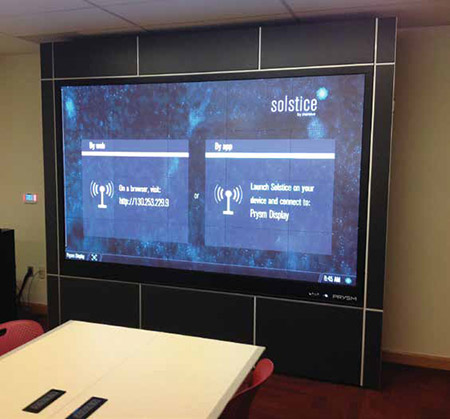INTEGRATORS CHOOSE COLLABORATIVE TECHNOLOGIES IN CLASSROOMS
Let the plotting begin.

The University of Denver recently deployed Mersive’s Solstice software in the university’s Center for Statistics and Visualization to facilitate collaborative learning and the presentation of research findings. The center selected Solstice to transform its Prysm video wall into an interactive learning tool for wireless collaboration and visualization among students, instructors, and researchers. As the end of the school year looms, now is the time to strategize your upcoming education projects with a focus on connections and collaboration in the classroom. And this is not the classroom you see in your high school yearbook.
“The classroom of today looks very different than that of even a few short years ago, and AV integrators are an important part of the movement toward an open classroom environment, including active learning, distance learning, and the flipped classroom,” said Greg Schwartz, president, BTX Technologies. “In addition to having a thorough understanding of the underlying technologies required to build the backbone of any complex display system, integrators now need access to new solutions that create and support these new educational requirements.”
The addition of personal devices such as tablets and Chromebooks in classrooms plays a big role in the transformation. “They’ve paved the way for interactive teaching even more so than in the past,” noted Nick Belcore, executive vice president, Peerless-AV. “With the ability to enter a virtual environment, this is the first step in collaboration from teacher to student.”
With collaborative technology, students have the opportunity to ask and investigate questions that may not be the main focus of what’s presented, but still aid in the learning. “Students can delve into more specific inquiries that may not apply to all of the attendees, and it will give them a voice in the decision-making process,” Belcore said. “These opportunities are considered essential for both self-regulated learning and motivation.”
This shift to collaborative learning will be the biggest demand going forward from clients in K-12 up to higher education, and it represents more than a technology learning curve.
“It’s a paradigm shift where the teachers will have to facilitate the learning process, but will not necessarily solely conduct it as they have done in the past,” Belcore said. “There will be a new shift in thinking to where many seasoned educators may find it counterintuitive to have the students set their own goals, in which case adaptation will be required from many.”
BTX has actively searched for the best solutions that the K-12 and higher education markets are demanding, and notes three emerging technologies that are game changers in this space, Schwartz said.
“In a collaborative setting, students and teachers alike should expect to walk into a room, easily connect to a display, and share work wirelessly and seamlessly from their individual devices,” he said. “This is the baseline expectation, but there is so much more that goes on beneath the surface: the need for moderator control for content review and for maintaining subject flow, IT bestpractice policies for bandwidth and security requirements, and cross-platform support for Microsoft, Apple, and Android devices.”

A Peerless-AV projector mount works well in a classroom setting.
In addition, there are constantly changing feature improvements, which is why the integrators working with BTX have embraced software-based solutions. “As features become available, a simple upgrade provides the latest, greatest features in a way that a firmware upgrade just can’t provide,” Schwartz said.
Schwartz also notes lecture capture as an important part of connecting students for effective learning. “We’ve seen an increase in available funding for this technology, especially in higher education,” he said. “Having the ability to specify a product for streaming live or on-demand over IP-enabled networks opens up new doors for integrators to move beyond the four walls of the classroom or lecture hall. By capturing multiple video and audio sources such as computers, mobile devices, cameras, and microphones gives students the experience of being in the classroom, even when watching live remotely or viewing at a later date. Having a solution that offers flexible recording and streaming options from layout to bandwidth control allows for customizing the solution to best suit the institution’s requirements, while meeting and exceeding the students’ requirements.”
Finally, internet protocol television (IPTV) delivers centrally managed, user-appropriate content—perfectly packaged for the education market—across the network. Content comes from many sources: broadcast TV, in-house production, classrooms from across the country or across the world, live events and recorded media, just to name a few. Integrators need to have a solution that provides high-quality video, is easy to program and manage, and is scalable as requirements change.
This is just a taste of what we see happening in the education market today.
Hybridization

A group collaboration space with two student tables uses FSR’s HuddleVU collaboration system, along with an instructor station using FSR’s Flex control system in the John and Margaret Walson Communication Hall at Muhlenberg College, Allentown, PA.
There is a middle ground between the traditional and the open classroom concept and that is hybridization, according to Gina Sansivero, director of business development, education, FSR.
“Hybrid is coming onboard,” she said. “What we see most on campuses are traditional classrooms because so many colleges are old and entire buildings can’t be overhauled at once. The most common classroom in the U.S. is traditional with some tech in there such as boards, screens, audio, and control, but still operating in a traditional format. With new construction and renovation, the idea is that rooms will be future-resistant with a lot of changes coming, and students expecting more collaboration.”
A lot of students and instructors are not familiar with open, active learning environments and so the technology is not always being utilized in the manner in which it was developed. What happens is that the institutional design has to change its pedagogy, and that is time consuming for traditional model instructors.
Students who are used to being spoken to in a traditional lecture might find that the active learning collaborative space is different for them.
“Research shows that they discover different types of success in an open classroom, but the idea of learning is going to have to change,” Sansivero added. “While we in AV technology and tech managers have been developing this concept for years, students and professors are in the process of embracing it.”
The K-12 arena differs in that younger students are more malleable, since they are most likely getting an earlier start with technology. “Their recognition is amazing,” Sansivero said. “And many newer K-12 teachers are entering the field ready for the open classroom.”

College campuses use Peerless-AV Xtreme Outdoor Landscape Kiosks with Touch to help navigate the area.
On the flip side, primary education institutions typically don’t have access to the vast financial resources of higher education, and K-12 public schools may be strangled by budget constraints, especially in very small districts and counties.
“A lot of manufacturers are coming out with smart furniture that is customizable, flexible, and intuitive for hybrid classrooms,” Sansivero noted. “Certain desks or tables can be pulled apart or configured in rows for a lecture.”
Integrators can hang displays on furniture or on walls, making the technology more flexible for instructors. All of these options make an installation more aesthetically pleasing and may keep it in character with the design of the space itself.
“What integrators should keep in mind is that from the beginning, they have to enable themselves to be part of team of stakeholders,” Sansivero concluded. “That team should include consultants, tech managers, instructional designers, end users, architects, and students, sitting down to ensure that all stakeholders have a say. The goal is for instructors to be comfortable and for students to suggest how they want to learn.”











